
Chiang Mai, the "Rose of the North," whispers tales of ancient kingdoms and beckons with its vibrant spiritual heart. Nestled amidst mist-shrouded mountains and verdant valleys, this northern Thai jewel offers a captivating blend of rich history, breathtaking natural landscapes, and a thriving contemporary culture. From gilded temples that pierce the azure sky to bustling night bazaars alive with the aroma of exotic spices, Chiang Mai promises an unforgettable journey for every traveler.
A Glimpse into Chiang Mai’s Storied Past
Chiang Mai’s history is as intricate and captivating as its silk weavings. Founded in 1296 by King Mangrai, it served as the capital of the Lanna Kingdom for over seven centuries, a period of significant cultural and artistic flourishing. The Lanna, meaning "a million rice fields," developed a unique identity, evident in their distinctive architecture, language, and religious practices. The city’s strategic location along ancient trade routes fostered interactions with neighboring kingdoms, contributing to its rich cultural mosaic.

Related Articles about Chiang Mai: A Timeless Tapestry of Culture, Cuisine, and Serene Beauty:
- Beyond the Cherry Blossoms: A Journey Through Japan’s Finest Hotels and Unforgettable Experiences
- Paris: A Symphony of Charm, History, and Unforgettable Experiences
- Chiang Mai: The Rose of the North – An Ultimate Travel Guide
- The Jewel of Arabia: A Grand Tour of the UAE’s Best Hotels, Attractions, and Travel Essentials
- A Tapestry of Wonders: Unveiling the Treasures of Turkey
Throughout its existence, Chiang Mai faced periods of Burmese rule and Siamese influence, each leaving its indelible mark. The city’s resilient spirit is reflected in its numerous temples, many of which have been rebuilt and restored over centuries, standing as testaments to its enduring legacy. The moats and ancient walls that still encircle the Old City serve as tangible reminders of its defensive past, offering a charming backdrop for exploration.
Unveiling Chiang Mai’s Crown Jewels: Top Attractions
Chiang Mai’s allure lies in its diverse array of attractions, catering to a spectrum of interests. Here are some of the absolute must-sees:
1. Doi Suthep Temple (Wat Phra That Doi Suthep): Perched atop a mountain overlooking the city, Doi Suthep is arguably Chiang Mai’s most iconic landmark. The journey itself is an experience, with a winding road offering increasingly spectacular vistas. Once you reach the summit, a Naga-lined staircase of 306 steps leads to the temple’s golden chedi, which is said to enshrine a relic of the Buddha. The panoramic views of Chiang Mai from here are simply breathtaking, especially at sunrise or sunset. The temple grounds are also home to smaller shrines, intricate murals, and a serene atmosphere conducive to contemplation.
2. Old City Temples: The heart of Chiang Mai is its ancient walled city, a UNESCO World Heritage tentative list site, peppered with an astonishing number of exquisite temples. Each temple possesses its own unique charm and architectural style:
- Wat Chedi Luang: Once home to the Emerald Buddha, this majestic temple features a colossal Lanna-style chedi, partially destroyed by an earthquake in 1441 but still awe-inspiring. Its imposing presence and historical significance make it a vital stop.
- Wat Phra Singh: Known for its beautiful Lanna architecture and revered Buddha image, Wat Phra Singh is a vibrant and active temple. The intricate wood carvings and the serene ordination hall are particularly noteworthy.
- Wat Phan Tao: This unique temple stands out with its Wihan (assembly hall) constructed entirely of teak wood, showcasing remarkable craftsmanship. It’s a peaceful oasis within the bustling city.
- Wat Chiang Man: The oldest temple in Chiang Mai, Wat Chiang Man, houses two revered Buddha images, the Phra Sila and the Phra Kaew. Its serene courtyards and ancient structures offer a glimpse into the city’s earliest days.

3. Elephant Nature Park: For an ethical and responsible encounter with these gentle giants, the Elephant Nature Park is a must-visit. This sanctuary provides a safe haven for rescued elephants, offering visitors the opportunity to observe them in their natural habitat, feed them, and learn about their individual stories. It’s a deeply moving and educational experience, prioritizing the well-being of the elephants above all else.
4. Chiang Mai Night Bazaar: As dusk settles, Chiang Mai truly comes alive at its vibrant Night Bazaar. This sprawling market is a sensory overload in the best possible way. Browse through endless stalls selling an array of handicrafts, textiles, souvenirs, artwork, and imitation designer goods. The air is thick with the enticing aromas of street food – from Pad Thai and grilled skewers to mango sticky rice and refreshing fruit shakes. It’s the perfect place to hone your bargaining skills and soak in the lively atmosphere.
5. Warorot Market (Kad Luang): For a more authentic local experience, head to Warorot Market. This bustling local market is a riot of colors, sounds, and smells. You’ll find everything from fresh produce, fragrant spices, and local delicacies to clothing, household items, and traditional medicines. It’s a fantastic place to witness daily life in Chiang Mai and sample some truly authentic Thai flavors.
6. Sticky Waterfalls (Bua Tong Waterfalls): A short drive from the city, the Bua Tong Waterfalls offer a unique and exhilarating experience. These "sticky" waterfalls are composed of limestone deposits that create a grippy surface, allowing visitors to climb up the cascades with ease. It’s a fun and refreshing adventure, especially on a warm day.
7. Art & Culture Centers: Chiang Mai has a thriving arts scene. Explore the MAIIAM Contemporary Art Museum for modern Thai art, or delve into traditional Lanna arts at various smaller galleries and workshops scattered throughout the city.
8. Cooking Classes: Chiang Mai is a culinary paradise, and what better way to experience its flavors than by learning to cook them yourself? Numerous reputable cooking schools offer hands-on classes where you can master the art of Thai cuisine, from curries and stir-fries to delectable desserts.
Navigating Chiang Mai: Travel Tips for a Seamless Journey
To make the most of your Chiang Mai adventure, consider these practical tips:
- Visa Requirements: Check the visa regulations for your nationality well in advance. Most nationalities are granted visa-exempt entry for tourism purposes for a specified period.
- Currency: The local currency is the Thai Baht (THB). ATMs are widely available, and credit cards are accepted in most hotels, larger restaurants, and shops.
- Language: The official language is Thai. While English is understood in tourist areas, learning a few basic Thai phrases like "sawasdee ka/krub" (hello) and "khob khun ka/krub" (thank you) will be greatly appreciated.
- Dress Code: When visiting temples, it’s essential to dress modestly. This means covering your shoulders and knees.
- Health & Safety: Chiang Mai is generally a safe city. Drink bottled water, be mindful of street food hygiene, and use mosquito repellent, especially during the evenings.
- Bargaining: Bargaining is expected in markets and with tuk-tuk drivers, but always do so with a smile and respect.
- Respect Local Customs: Be mindful of local customs and traditions. Avoid pointing your feet at Buddha images or people, and always show respect to monks.
Your Home Away From Home: Accommodation Options
Chiang Mai offers a diverse range of accommodation to suit every budget and travel style:
- Luxury Hotels: For an indulgent experience, consider the opulent hotels with stunning views, infinity pools, and world-class service. Many are located within or near the Old City, offering convenient access to attractions.
- Boutique Hotels & Guesthouses: The Old City is brimming with charming boutique hotels and guesthouses housed in beautifully restored traditional Thai buildings. These offer a more intimate and personalized experience.
- Mid-Range Hotels: You’ll find a plethora of comfortable and well-equipped mid-range hotels throughout the city, offering excellent value for money.
- Budget Hostels: For budget-conscious travelers, Chiang Mai boasts a vibrant hostel scene, providing dormitory beds and private rooms in a social atmosphere.
- Bungalows & Villas: For those seeking more privacy and a connection with nature, consider staying in a bungalow or villa on the outskirts of the city, often surrounded by lush greenery.
Getting Around Chiang Mai: Transportation Options
Navigating Chiang Mai is relatively easy and affordable:
- Songthaews: These red shared taxis are the most popular and economical mode of transport. They operate on fixed routes, but you can flag them down and tell the driver your destination. Agree on the fare before you get in.
- Tuk-Tuks: A quintessential Thai experience, tuk-tuks offer a more personalized and faster ride. Negotiate the fare before your journey.
- Grab: The ride-hailing app Grab is widely used in Chiang Mai, offering a convenient and transparent way to book taxis and private cars.
- Motorbike Rentals: For the adventurous, renting a motorbike offers the freedom to explore at your own pace. However, ensure you have an international driving permit and are comfortable with Thai traffic.
- Walking: The Old City is best explored on foot, allowing you to discover hidden temples, charming cafes, and local shops.
- Bicycles: Bicycle rentals are also a popular option for exploring the Old City and its surroundings.
The Perfect Time to Visit Chiang Mai: Embracing the Seasons
Chiang Mai experiences a tropical climate with three distinct seasons:
- Cool and Dry Season (November to February): This is widely considered the best time to visit Chiang Mai. The weather is pleasant, with average temperatures ranging from 20-28°C (68-82°F). Humidity is low, and there’s minimal rainfall, making it ideal for outdoor activities, temple hopping, and exploring the surrounding countryside.
- Hot Season (March to May): Temperatures soar during this period, often exceeding 35°C (95°F). While still manageable, the heat can be intense, making it less ideal for strenuous activities during the day. However, evenings are usually cooler and more pleasant.
- Rainy Season (June to October): This season brings heavy rainfall, often in short, intense bursts, usually in the afternoon or evening. While it might not be ideal for constant sunshine, the rain brings lush greenery to the landscape, and accommodation prices can be lower. Temples and indoor attractions are still accessible.
A Final Word on Chiang Mai:
Chiang Mai is more than just a destination; it’s an experience that lingers long after you depart. It’s a place where ancient traditions harmoniously coexist with modern life, where spirituality is woven into the fabric of daily existence, and where the warmth of its people is as inviting as its tropical sun. Whether you seek cultural immersion, spiritual solace, culinary delights, or adventurous escapades, Chiang Mai offers a timeless tapestry waiting to be unraveled. Pack your bags, open your heart, and prepare to be enchanted by the enduring magic of the Rose of the North.





